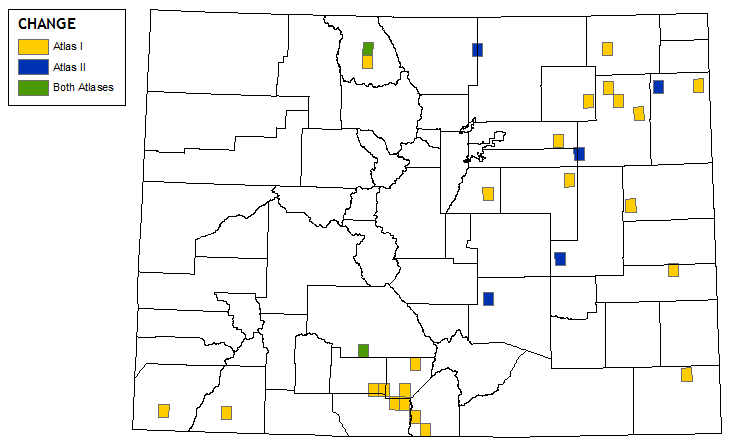November Nature Almanac: Short-eared Owls - Silent Hunters of the Marsh
By Scott Severs with Stephen R. Jones and Ruth Carol Cushman
November 2022
Winter for us is a time for raptors, an exciting time to see a rare species or one of the many morphs (subspecies or plumage variants) that come to Colorado. We live in winter habitat for birds of prey. Bald Eagles, Rough-legged Hawks, and other daytime-foraging raptors hunt for voles, mice, and prairie dogs in the county's remaining open space and farmlands. Night-time avian hunters also find their way here, exploiting the nocturnal habits of mammalian prey. Owl species that migrate here include the Long-eared, Short-eared, and, rarely, Snowy Owls. One of our personal favorites is the Short-eared Owl. Although these owls nest in some parts of Colorado, the opportunity of our observing one usually occurs in years when there’s a shortage of prey in other regions.
Short-eared Owl perched on fence post in grasslands. Photo by Stephen R. Jones.
Named for their small ear tufts (which are rarely visible) Short-eared Owls are medium-sized, just slightly smaller than a crow. Open country specialists, they perch in exposed locations where their fawn and brown feathers help conceal them. These owls prefer to live and forage in wetlands, pastures, and grasslands, whereas most local owls hunt in areas of trees. Short-eared Owls often occur in places frequented by Northern Harriers, another open country specialist.
When present, Short-eared Owls are very conspicuous, which is one reason we like them so much. Sharing many of the hunting techniques of the Northern Harrier, they hunt in the open on the wing, looking and listening for prey on the ground, in cattails, or in prairie grasses. Their round facial disk serves as a sophisticated listening device, funneling the sounds of mice and voles to their ears. As do most owls, Short-eared Owls fly on silent wings, their rounded and soft feather edges muffling sound as the feathers cut through the air. When they detect prey, their flight stalls and they may hover a second or two, then they plunge down talons- first to grab an unsuspecting mouse or vole.
Although they usually hunt in the dim light of dusk and dawn, these owls are occasionally seen in the day. During seasonal population explosions of their prey, they will gather over the marsh along with the harriers, taking advantage of the wealth of food. Sometimes squabbles ensue between harriers and owls fighting for the same vole!
The aerial talents of this owl are obvious in the courtship displays of the males. Toward the end of winter the males fly in a floppy, stalled manner until they are high above the marsh, at which point they dive and swoop with loud claps of the wings.
In this audio recording from the Kenai Peninsula, Alaska, you can hear the initial hoots then the rapid wing slaps of a displaying Short-eared Owl. Recording by Brian McCaffrey, May 1988, Macaulay Library ML50052.
One of the few owl species that builds its own nest, they nest from April through June in open country. Nests are located on the ground, often in cattails or rushes. Both adults create a shallow depression and add feathers, grasses, and plant stems.
The number of eggs the female lays varies greatly from four to seven, and occasionally up to a dozen. The number of eggs correlates with the availability of rodents since high mice numbers bode well for the survival of hungry owlets. Females incubate the eggs for about 21 days, and the young fledge from the nest about a month later. Faithful to their nest and young, Short-eared Owls aggressively defend their family, diving at Great Blue Herons and other large birds that may threaten their nest. They will also feign injury to draw coyotes and foxes away from the nest site.
Among the most widespread of owl species, within North America Short-eared Owls can be found in appropriate habitats from the northern coasts of Alaska and Canada southward to the midsection of the lower 48 states. The San Luis Valley is their breeding stronghold in Colorado, with lesser numbers nesting on our plains. However, reported nests are rare throughout most of Colorado, which lies near the southern extent of the Short-eared Owl's North American breeding range. Recent results from the Colorado and Nebraska breeding bird atlases suggest that numbers of nesting pairs are declining as global warming encourages the owls to breed farther north, where their favored prey remain more abundant.
Locations of Short-eared Owl breeding activity recorded during the Colorado Breeding Bird Atlas I (1987-1995) and Atlas II (2007-2012) efforts. Map from the Colorado Breeding Birds Atlas II.
Locally, Boulder Reservoir and Boulder Valley Ranch Open Space still offer occasional opportunities to observe these birds in winter. We’re hoping for a chance to see these beauties again this winter.
Other November Events
Winter sparrow flocks gather in local shrub patches and overgrown fields. Watch for White-crowned, White-throated, Harris’s and Swamp sparrows foraging for wild grass and forb seeds along with juncos and Song Sparrows.
Snow, Ross’s and Cackling Geese arrive from the north joining local flocks of Canada Geese at local ponds and reservoirs.
Mink are more visible along the water’s edge of streams and ponds, hunting fish and waterfowl along the frozen edges of open water.
Because wildflowers and garden flowers continued to bloom longer than usual this year, butterflies continue to flit about even after a light snowfall. We saw two painted ladies on October 28!


